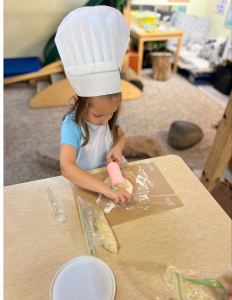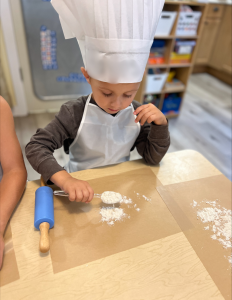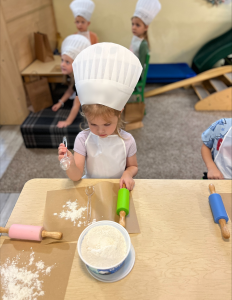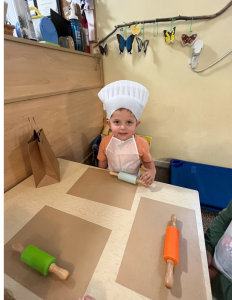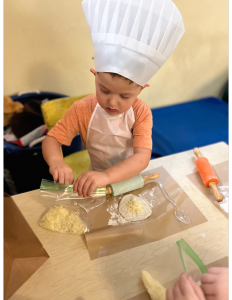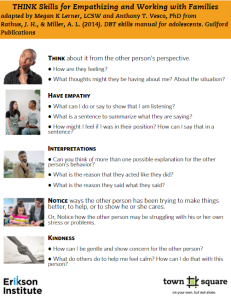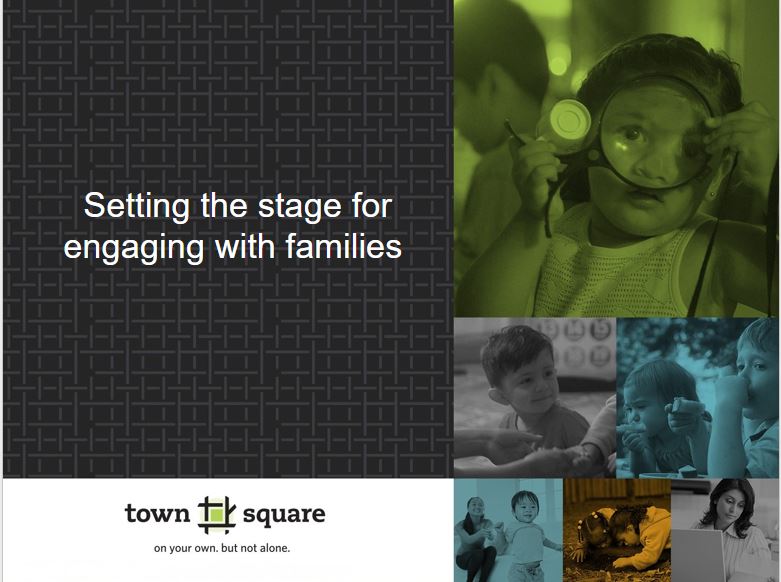When a family makes a commitment to a child care program, they’ve made a statement that they trust the provider to keep their child safe and healthy, and provide an educational and loving environment for that child to grow in. This can be the first step to a strong and long-lasting relationship when educators take the time to intentionally build that with the families of children in their care.
Why is it beneficial to build relationships between educators and families? Often, child care educators are a family’s first experience with having an unrelated adult care for their child. As the introduction to extrafamilial care, child care providers set the tone for the way families engage with all of their child’s education. Setting the stage with warm and caring professional relationships will support families engaging with all of the systems that they will participate in with their child.
A strong relationship between family and child care provider also directly and immediately benefits the child. Family child care educators and families are the people who spend the most time with a child and are in the best position to advocate for them and support their growth and development. When families and educators build strong relationships together, they can communicate more effectively when concerns or disagreements arise. Maintaining relationships with families offers educators the opportunity to better understand every child, and it can give families the comfort necessary to participate in the child’s program and share the interests and skills with the educator and children.
How do family childcare educators seize this opportunity to connect with families and build those professional relationships?
- Start before day one: Although families already have plenty of paperwork to do to enroll, some educators add a “getting to know you” page where families can answer questions that will support the provider in understanding their families history, preferences, and needs. Some sample questions include:
- What language(s) does your child hear and speak at home?
- Who lives in your child’s home(s), including pets? Who do they visit with frequently?
- What do you like to do as a family?
- What does your child typically choose to play with?
- Tell a story: The days can get busy, but proactively making note of something the child said or enjoyed during the day to communicate with families at departure time will maintain that relationship. Prioritizing face to face communication, even for you a minute or two at a time, will make bigger conversations easier when they become necessary. This doesn’t have to happen every day for every child, but the first few days a child is in a program are extra important for making this connection.
- Invite them in: When children are interested in a subject that a parent knows about, or the opportunity for a field trip arises, inviting families in either individually or as a group to share their experience or supervise a trip will build bonds and memories.
For Reflection:
What one action can I add to my day that will help build those reciprocal relationships with families?
Baking with preschoolers is has so many academic benefits. It helps develop their fine motor skills through many actions like mixing, pouring, and kneading dough. It also enhances their language skills by introducing new vocabulary related to baking, improves hand-eye coordination, and teaches basic math concepts through measuring, sequencing and following steps in order. They also learn about cause and effect, temperature, floating, melting, freezing and (sometimes!) burning.
While you’re waiting for the rolls to bake, the children might be offered the opportunity to draw their process to make a recipe card to share with their families.
Our recipe:
Materials:
- Parchment paper
- Rolling pin
- Baking Sheets
- Pastry brushes
- Flour
- Dough (can be found frozen or refrigerated)
- Butter
- Cheese and other toppings!
- Pre heat oven to 350º
- Wash your hands and the table you are working on
- Tape down parchment paper, about the size of a lunch tray (I just used scotch tape to tape it down so it didn’t move)
- Flour on the paper
- Roll out your dough
- Add shredded cheese and pepperoni (we counted 5)
- Roll it to make a roll brush melted butter on the top
- Bake for 10-12 minutes
- Let cool, eat and enjoy!
Often families, especially for their first child, are worried about sending their baby to group care, having absorbed the idea of a single primary caregiver being the ideal. But Babies in Groups: Expanding Imaginations, by Ben S. Bradley, Jane Selby, and Matthew Stapleton, is a painstakingly researched book demonstrating how infants are socially engaged and engaging creatures from birth, and from six months can observably take pleasure in interacting with other babies. This article from The Conversation offers some of their findings, and would make a great addition to your enrollment packet!
For reflection:
How do the babies in your care participate in the group?
In what ways can you facilitate their participation?
Has this article changed the way you see their interactions?
Sometimes in difficult conversation with families, it can be difficult to empathize and maintain what feels like a productive conversation. Using the acronym THINK, here are some tips from Megan K. Lerner, LCSW and Anthony T. Vesco, PhD for maintaining and building a productive relationship.
- Personally acknowledge and greet each family and child, with a smile as they enter the room.
Doing this simple task helps build meaningful and respectful relationships with families. It’s the first interaction the family may have each day and will go a long way in helping families feel welcome. Calling the parent by their name (unless otherwise specified by the parent) and their child by their own name, makes it personal. We want parents to know we are happy to see them and their child and greeting them by their first name is much nicer and more personal than just saying “hello”. If you are unsure how to pronounce their name, it’s best to politely mention you are unsure and ask them how to say it and repeat it back.
- Have daily and ongoing conversations with families.
Each day talk to the family and share something their child did that was positive. Either a new skill learned, or an interaction with another child you observed that was especially nice are examples. Try to be engaging, smile and actively listen. Daily conversations build trust and allows for other conversations to evolve over time, allowing you to learn about the family and their child. When trust is built, families are more comfortable sharing information that may be helpful in meeting the child’s needs and in some cases the family’s needs as well.
- Make sure all families and all children are represented.
Displays around the classroom should represent all children. They should depict varying abilities, languages, and cultures. This need to be done in a non-stereotypical way. The environment should include a combination of pictures, books, dolls, music, and household items that are familiar to children and things they would find in their own home and community. Ask families to bring in family photos of all family members, doing activities they enjoy as a family. Display and make classroom books with them. Displays should be at both child height and parents’ height. Offering seating for adults to sit shows families that they are welcome to stay awhile, and you care about their comfort.
- Provide ways for families to volunteer.
When families can participate one way or another in the childcare program, they feel invested and included. Childcare programs have many different task to manage throughout the year, why not get the help of the families. Parents usually are very happy to lend a hand or offer skills or services they may have. It’s also fun to get the whole family involved. Some ways parents can volunteer might be, a spring or fall clean up on the playground, repairing equipment, sewing things for the classroom, reading a book to the children, or doing a cooking activity with a small group of children. Remember that not all families will be able nor want to volunteer in the classroom and we want to be respectful of this. Providing a list of things, parents can work on at home will allow these families to also feel valued and connected too. Remember part of feeling welcome is knowing you are valued no matter how or if you choose to participate.
- Provide resources and support for families.
Create a specific area in the childcare program where parents can go to get resources pertinent to child development, parenting, health and safety, product recall information and child nutrition as well as social service supports and free events available in your area. Providing resources that pertain to parenting and child development will let parents know that you care about their family outside the walls of the childcare. The location should stay consistent so parents will know where to find these resources and can visit without the help of staff. Providing a small lending library if you’re able, may be useful too. Keep this area uncluttered and organized so parents will want to visit and can find what they are looking for. Remove outdated information in a timely manner.
Relationships with families are at the heart of an early childhood professional’s work. Building and sustaining these relationships benefits the children in your care as well as your business. Family engagement can look different for different programs– some programs plan events during the day or after hours for families to drop in, others integrate a more casual approach where families can spend time in the program as they’re available. Family engagement can also look more formal, with structured conferences or requesting volunteers for field trips. Welcoming families into your program is the first step to building strong relationships.
Town Square Research to Practice Statements offers information from theory and research with examples and suggestions for what it means in your work with children. This RtoP focuses on parent engagement and how to develop a healthier relationship with parents.
Explore ways to build relationships with families in your program in this virtual training for Family child care providers connecting policies and program philosophy to support the inclusion and engagement of all families.
Objectives:
- Through exploring ways to build relationships with families, family child care providers will describe and develop various ways to support and engage families.
- As family child care professionals define their vision and philosophy, they will connect these with policies and procedures that support the inclusion of all families in their program.
Town Square Indiana modules can be found in Indiana Learning Paths. Please follow the link below to log into your I-lead account and click on “Start Your Indiana Learning Path”. Once in Indiana Learning Paths please search for:
Town Square – Setting the Stage for Engaging with Families

